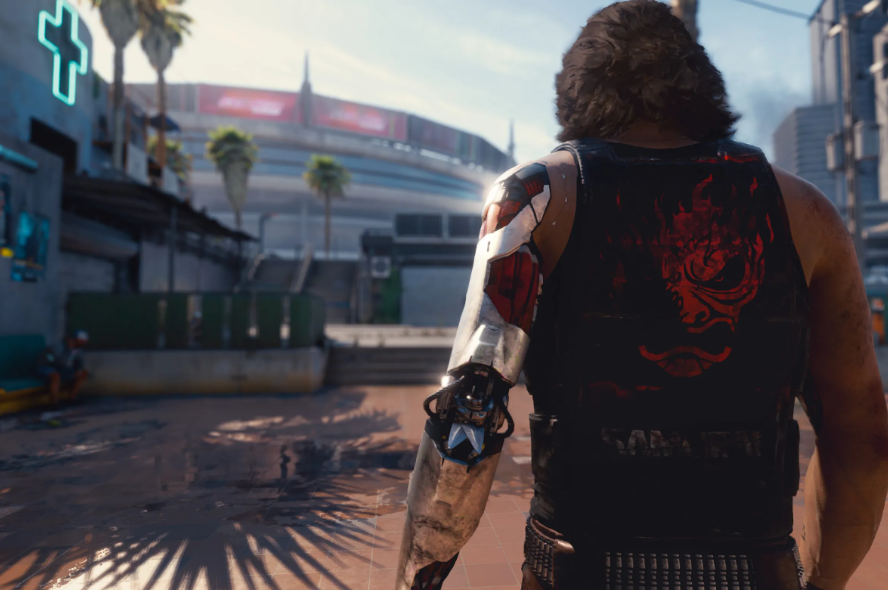Introduction
When Cyberpunk 2077 was first announced, it promised a revolutionary RPG experience—an expansive open world, deep narrative choices, lifelike AI, and next-gen visuals, all wrapped in the dazzling chaos of Night City. But when the game finally launched in December 2020, it fell far short of expectations. Plagued by game-breaking bugs, poor performance on consoles, and missing features, Cyberpunk 2077 quickly became one of the most controversial game releases in recent memory.
Fast forward to 2025, and the question now is: has Cyberpunk 2077 redeemed itself? With years of updates, patches, and the critically acclaimed Phantom Liberty expansion, CD Projekt Red has poured immense effort into fixing and evolving the game. Many players are revisiting the title—or experiencing it for the first time—and finding a vastly improved version of the futuristic RPG that once disappointed them.
In this article, we’ll explore Cyberpunk 2077’s journey from troubled launch to potential triumph. Has it finally become the game it promised to be? Let’s find out.
The Rocky Launch: What Went Wrong in 2020
When Cyberpunk 2077 launched on December 10, 2020, it was one of the most highly anticipated video games in history. Developed by CD Projekt Red—the studio behind the critically acclaimed The Witcher 3: Wild Hunt—expectations were sky-high. Backed by a massive marketing campaign, A-list casting (including Keanu Reeves), and promises of an open-world RPG unlike any other, Cyberpunk 2077 2025 was poised to redefine the genre. But what followed was a storm of disappointment, technical chaos, and one of the most controversial launches in gaming history.
The game released in a clearly unfinished state, especially on last-gen consoles like the PlayStation 4 and Xbox One. Players encountered a flood of bugs, crashes, and performance issues that rendered the game almost unplayable for many. Textures failed to load, characters floated mid-air, cars teleported randomly, and missions broke without warning. Even on high-end PCs, bugs were frequent and immersion-breaking.
Critics initially praised the game’s narrative ambition, world design, and aesthetics, but these were overshadowed by its unstable performance. Social media was flooded with glitch compilations and refund requests. The backlash was so severe that Sony delisted Cyberpunk 2077 from the PlayStation Store for over six months—a rare and damaging move for such a major title.
Behind the scenes, reports revealed a rushed development cycle plagued by crunch, missed deadlines, and unrealistic internal goals. Many features that were promised in trailers and developer interviews—like dynamic police behavior, wall-running, or meaningful life path choices—were either cut or underdeveloped.
CD Projekt Red’s reputation, once a symbol of consumer-friendly development, took a major hit. Trust was broken, stock prices dipped, and lawsuits from investors followed. Despite having sold over 13 million copies within a few weeks, Cyberpunk 2077 quickly became a cautionary tale in overpromising and underdelivering in the gaming industry.
The launch of Cyberpunk 2077 in 2020 wasn’t just a failure of code; it was a breakdown of trust, expectations, and development ethics. But as we’ll see in the following sections, CD Projekt Red didn’t give up. Instead, they began what would become a years-long journey of rebuilding both the game and their credibility.
Major Updates and Fixes Over the Years
In the aftermath of Cyberpunk 2077’s disastrous launch, CD Projekt Red committed to a long-term redemption arc. What followed was a series of major patches, hotfixes, and overhauls that gradually turned the game from a broken shell into a stable, enjoyable open-world RPG. Between 2021 and 2025, these updates didn’t just fix bugs—they reshaped entire systems.

2021: Stabilization and Core Fixes
The studio’s first priority was to make the game playable across all platforms. Patches 1.1 and 1.2 were massive, addressing hundreds of bugs, stabilizing frame rates, and improving AI behavior. Crowds and traffic, once static and lifeless, began reacting more naturally. Quest-breaking glitches were patched, and performance on last-gen consoles, while still not ideal, became tolerable.
2022: Patch 1.5 and the Next-Gen Update
One of the turning points came with Patch 1.5, which introduced native support for PlayStation 5 and Xbox Series X|S. The game received visual upgrades, faster load times, ray tracing, and a much-improved UI. Alongside technical polish, the update brought gameplay improvements like enhanced combat mechanics, new apartments, and deeper romance options. The perk system was refined, and crowd AI received another boost—bringing Night City one step closer to life.
2023: Phantom Liberty and Update 2.0
Perhaps the most important revival came with the release of Phantom Liberty, a full-scale expansion that shipped with the groundbreaking Update 2.0. The expansion introduced a new district, Dogtown, and a gripping spy-thriller storyline starring Idris Elba. More importantly, Update 2.0 reworked core systems: a redesigned skill tree, smarter police AI, improved vehicle combat, and a new cyberware limit that encouraged strategic builds.
Gamers and critics alike began to take notice. Cyberpunk 2077 climbed back into positive Steam reviews and was praised for its transformation. By late 2023, many players and reviewers called it a “comeback story” and “one of the best RPGs of the decade.”
2024–2025: Continuous Improvements and Mod Support
Since 2024, CD Projekt Red has continued improving modding tools, performance, and quality-of-life features. Updates focused on community feedback, accessibility improvements, and enhancing replay value. While no sequel has been released yet, the developers confirmed that a Cyberpunk follow-up (Project Orion) is in development—proof that the franchise has been fully revived.
From broken beginnings to a respected RPG, Cyberpunk 2077’s road to redemption has been one of the most dramatic in gaming history.
Phantom Liberty Expansion: A Turning Point?
When Phantom Liberty launched in September 2023, it was widely hailed as the moment Cyberpunk 2077 truly became the game it had always aspired to be. More than just a traditional DLC, Phantom Liberty served as a soft reboot—introducing sweeping systemic overhauls, a gripping new storyline, and a gritty espionage setting that gave Night City fresh life.
Set in the lawless district of Dogtown, the expansion put players in the middle of a high-stakes political thriller. You join forces with Solomon Reed, played by Idris Elba, a grizzled sleeper agent from the New United States of America. The narrative tone shifted from dystopian chaos to Cold War-style intrigue, adding a level of maturity and nuance missing from the original campaign. Many fans praised the writing, character depth, and moral complexity, calling it one of the best stories CD Projekt Red has written to date.
But Phantom Liberty wasn’t just about story—it brought with it Update 2.0, a complete revamp of key gameplay systems. The skill tree was rebuilt from the ground up, offering more impactful perks and unique character builds. The cyberware system was redesigned with limits and trade-offs, pushing players to think more strategically about their augmentations. Police AI, which had been criticized since launch, now provided more realistic and escalating responses. Vehicle combat, finally introduced properly, allowed high-speed gunfights and netrunner hacks while driving.
Dogtown itself was more than a new location—it was a symbol of change. Verticality, environmental storytelling, and dense mission design made the area feel handcrafted and full of tension. Side quests were no longer filler; they told compelling mini-stories or shaped your relationship with key characters.
Critics and fans immediately noticed the shift. Gaming publications like IGN, GameSpot, and PC Gamer praised Phantom Liberty as “the real launch of Cyberpunk 2077.” It earned multiple “Best Expansion” nominations and helped repair the game’s reputation across communities.
For many players, Phantom Liberty was the moment Cyberpunk 2077 crossed the threshold from a promising concept into a genuinely excellent game. It was not just an addition—it was a transformation, signaling the beginning of a brighter, more stable era for Night City and its citizens.
What’s New in 2025? Current State of the Game
As of 2025, Cyberpunk 2077 stands as a shining example of gaming redemption—a title that has gone from one of the most infamous launches in history to one of the most polished and content-rich single-player RPGs on the market. Over the past few years, CD Projekt Red has doubled down on its promise to transform Cyberpunk 2077 into the immersive, choice-driven experience it was originally meant to be. And today, the game is not only stable but deeply engaging.
Stability and Performance Across Platforms
Gone are the days of broken quests, random crashes, and unplayable performance—especially on last-gen consoles. With multiple hotfixes and over a dozen major updates since launch, Cyberpunk 2077 2025 now runs smoothly on PlayStation 5, Xbox Series X/S, and modern PCs. Frame rates are consistent, bugs are rare, and loading times are much faster than before. Even Steam Deck support has improved significantly, making the game a solid handheld experience for on-the-go players.
Enhanced Visuals and Immersion
In 2025, Cyberpunk 2077 boasts enhanced graphics, especially on high-end PCs. With Path Tracing (Overdrive Mode) enabled, Night City looks more alive than ever. Reflections, shadows, and neon lighting create a strikingly realistic urban landscape. Improvements in crowd AI and NPC behavior have made the world feel reactive and dynamic, not just visually but in gameplay interactions as well.
Expanded Gameplay Features
Post-Phantom Liberty, CDPR introduced several quality-of-life and gameplay updates, further refining the mechanics:
- New Game Plus was finally added in early 2024, allowing players to carry over builds and gear with added difficulty layers.
- Vehicle Customization and Racing Leagues became a permanent feature, with new car models and tuning options.
- The housing system now lets players buy and customize safehouses in different districts, adding to the role-playing depth.
- AI companions for certain missions and open-world patrols were introduced, a long-requested feature that expands tactical options and narrative variety.
Dynamic World Events and Endgame Content
In an effort to make Night City feel more alive, CD Projekt Red added dynamic world events that players can stumble upon—gang wars, police raids, underground cyberware black markets, and more. The game now has procedurally generated side missions, ensuring that players always have something to explore even after completing the main campaign.
For endgame players, cyberspace arenas were introduced in late 2024, where you can test your build against digital constructs, rogue AIs, and wave-based enemies in a virtual battleground. These arenas offer rewards tied to your playstyle and help maintain engagement post-story.
Community Mods and Continued Updates
While CDPR confirmed there will be no major expansions beyond Phantom Liberty, they have continued to support the community by releasing tools for modders. As a result, the modding scene is thriving, offering everything from visual overhauls and gameplay tweaks to entirely new missions and romance paths.
Is Cyberpunk 2077 What Was Promised?
When Cyberpunk 2077 was announced back in 2012 and revealed in full during E3 2018, it was touted as a revolutionary RPG that would redefine the open-world experience. Gamers were promised a deeply immersive world, flexible storylines shaped by player decisions, a responsive city full of life, and cutting-edge visuals that would push gaming into the future. But when the game launched in December 2020, what players got was a very different reality: bugs, crashes, AI flaws, and an unfinished world—especially on older consoles.
Now, in 2025, it’s a fair question to ask: Did Cyberpunk 2077 ever become what it promised to be?
A Night City That Feels Alive
One of the biggest promises was an open world that truly lives and breathes around the player. While the initial version fell flat with robotic NPCs and shallow city interactions, today’s Cyberpunk 2077 offers a much more believable and reactive urban sandbox. AI has been improved drastically—citizens react more naturally to your actions, police chases are dynamic, and crowd density and behavior reflect the mood and time of day.
Night City is no longer a backdrop; it’s a character in itself. The addition of dynamic world events, spontaneous gang activity, and updated pedestrian AI creates a constant sense of immersion and unpredictability. It now aligns more closely with the living world we were promised.
RPG Systems That Matter
At launch, Cyberpunk 2077’s RPG systems—attributes, perks, lifepaths—felt undercooked. Many choices felt inconsequential. Fast forward to 2025, and we now have a refined perk system, expanded cyberware customization, and meaningful consequences to in-game decisions. Dialogue options tied to lifepaths and stats can now open or block critical mission outcomes, giving weight to your build and role-playing choices.
The much-requested New Game Plus mode, along with deeper endgame content, finally offers replayability and long-term progression.
Narrative Quality and Player Agency
Even from the start, CD Projekt Red’s strength has been storytelling, and that part of the promise largely held true. But now, thanks to Phantom Liberty and ongoing updates, players have even more meaningful narrative branches. Multiple endings feel distinct and emotionally charged. Quests are no longer linear—side stories now evolve dynamically based on your choices, companions, and past allegiances.
The game finally supports true player agency, with missions offering various outcomes beyond simple “success” or “fail.” This nuance makes the game far closer to the Blade Runner meets Deus Ex fantasy many hoped for.
What Still Falls Short?
Despite the enormous progress, Cyberpunk 2077 is not without remaining limitations. Some promised features—like wall running, deeply branching life paths, and full romance arcs—never made it back into the game. While modding has filled in some of these gaps, they’re still reminders of what could have been.
Moreover, while Night City is beautiful, it remains somewhat isolated. You can’t fly to other cities, explore space, or truly join factions in an emergent, sandbox-style gameplay loop.
In conclusion, Cyberpunk 2077 in 2025 is very close to the game we were promised—and in some areas, it even exceeds expectations. It may have taken five years, but for most players today, it finally feels like the RPG of the future we were once shown in those jaw-dropping trailers.
How It Compares to Other RPGs in 2025
In 2025, the role-playing game (RPG) landscape is more competitive than ever. With titles like Starfield, The Witcher 4 (teased but not yet released), Baldur’s Gate 3 Enhanced, and The Elder Scrolls VI (still in development limbo), Cyberpunk 2077 stands among a growing variety of immersive, choice-driven experiences. But how does it stack up against the best RPGs today?
Narrative Depth and Player Choice
Few games rival Cyberpunk 2077 in narrative complexity. While Baldur’s Gate 3 set a new bar for branching storylines and reactive companions, Cyberpunk delivers something different—a gritty, cinematic narrative grounded in a dystopian reality. Where Starfield offers expansive planetary exploration, Cyberpunk thrives in its densely packed urban storytelling.
Its storytelling now feels more personal and emotionally resonant, especially after the Phantom Liberty expansion. Unlike the traditional hero’s journey in most RPGs, Cyberpunk tells a story of identity, mortality, and consequence. That mature storytelling gives it a unique place in the genre.
Visual Fidelity and World Design
Visually, Cyberpunk 2077 is still among the top-tier RPGs. Thanks to continuous updates and DLSS/FSR integration, its ray-traced lighting, neon-drenched backdrops, and immersive interiors remain some of the most impressive in gaming. Even when compared to Starfield’s planetary realism or Avowed’s stylized fantasy world, Cyberpunk’s Night City feels more alive and tangible.
Combat and Customization
In terms of combat, Cyberpunk now offers fluid and fast-paced gunplay, slick melee combat, and powerful cyberware-enhanced abilities. While Starfield and Outer Worlds 2 offer more conventional shooting mechanics, Cyberpunk wins in terms of style and build diversity. From hacking enemy systems to deploying mantis blades or monowires, the options are satisfyingly varied.
RPG systems have also caught up, finally making your attribute choices matter in dialogue, combat, and exploration—something that was previously a weakness.
Open World and Replayability
Where Elden Ring and Baldur’s Gate 3 offer expansive replay value through exploration or class mechanics, Cyberpunk 2077 still leans more into story-driven design. That means while the experience is rich, it’s not infinitely replayable—though New Game Plus and modding extend the shelf life significantly.
Bottom line? In 2025, Cyberpunk 2077 can confidently stand shoulder to shoulder with the best RPGs. It may not be the most expansive or traditionally “open,” but in terms of narrative quality, visual impact, and urban worldbuilding—it remains a benchmark in modern RPG design.
Final Verdict
In 2025, Cyberpunk 2077 has finally achieved what many hoped for at launch. From its rocky beginnings in 2020 to its present refined state, the game now delivers a polished, deeply immersive, and narratively rich RPG experience. Thanks to relentless updates, bug fixes, performance overhauls, and the impressive Phantom Liberty expansion, Night City now feels more alive, dynamic, and responsive than ever before.
While Cyberpunk may still not offer the open-ended freedom of games like Baldur’s Gate 3 or Elden Ring, it excels in cinematic storytelling, world design, and futuristic immersion. Its blend of first-person combat, hacking, and impactful character choices create a distinct identity in today’s RPG market.
If you gave up on the game after its troubled launch, now is the time to return. And if you’ve never played it—2025 offers the best version yet. Cyberpunk 2077 may not have rewritten the RPG rulebook, but it has earned its redemption and proven itself as one of the genre’s most iconic titles.



